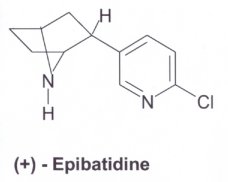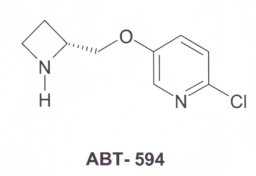Epibatidine
(ABT-594)
For centuries now, tribes in South America have used deadly secretions from poisonous frogs as a way of harming their enemies. The tribesmen would wipe the tips of their arrows on the frogs’ skin, coating it with a toxin which, if entered into the bloodstream caused convulsions, paralysis and eventually death.
History:
 Discovery of Epibatidine:
Discovery of Epibatidine:
In 1976, John Daly and his research group from the National Institute of Health took scrapings of the skin of a poisonous Ecuadorian frog, Epibpedobates tricolor. They discovered, through tests on mice, that the frog’s poison provided pain relief 200 times higher than that of morphine. Unfortunately, as the frogs were endangered, only very small amounts of the chemical were extracted and it wasn’t until the late-eighties, when NMR spectroscopy was in use, that the structure of this poison was determined.
Epibpedobates tricolor

Epibatidine (C11H13ClN2 208.6901) is a piperidine alkaloid, which resembles that of nicotine. Epibatidine binds to nicotinic acetylcholine receptors (nAChR) rather than opiate receptors, which is common of most analgesics such as morphine.
When the Epibatidine binds to the specific receptor, it blocks any neural transmission, thus no pain is felt. Unfortunately, Epibatidine binds not only to nAChR in the brain, but also at other neuro-muscular junctions throughout the body. This is not desired as it caused seizures and respiratory and digestive problems.
 Discovery
of ABT-594:
Discovery
of ABT-594:
After screening and testing 500 similar alkaloid compounds, ABT-594, whose chemical structure closely resembles epibatidine, was shown to have the same analgesic qualities but without being toxic or addictive. It has a very low affinity for the nAChR, which cause the paralysis effect, but still binds to receptors in the central nervous system which control pain perception.
The most widely used analgesic for treating intense pain is morphine, but one big drawback to opiate drugs is that they are tremendously addictive. Replacements for these drugs have been long awaited and ABT-594 could be the answer to this problem. Currently, tests are being carried out on humans to check for addiction and other side effects. But soon, what was once used as a poison against predators could be the inspiration behind a whole new class of painkillers.
![]()
References:
Epibatidine; Matthew R. Dowd: http://www.phc.vcu.edu/feature/epi/index2.html#5
Altering Chemistry: Epibatidine a Novel Alkaloid; Suzanne Strong: http://wwwchem.csustan.edu/chem4400/sjbr/strong98.htm
http://backandneck.about.com/library/weekly/aa011598.htm
http://www.accessexcellence.org/AB/BA/pain_Meds/pain10.html
Molecular Structures:
http://www.abdn.ac.uk/chemistry/abt/
Images:
http://www.portfolio.mvm.ed.ac.uk/studentwebs/session2/group13/index.html
http://www.coffeecup.com